Here on The Review, we've covered just about every aspect of sales in extreme depth — from founder-led sales to building teams to pricing. But less has been written about what happens post-sales, and specifically, how to keep customers once you've worked so hard to acquire them.
The "leaky bucket" problem keeps founders up late at night. There are many levers you can pull to address it, but Gaurav Vohra says onboarding might be the most effective.
Gaurav Vohra is a growth specialist, leader, and advisor. He built Superhuman from the ground up — starting, scaling, and leading their growth, product, marketing, and analytics functions, and creating their iconic growth engine combining a high-touch product experience with viral distribution. He now advises high-growth startups, and publishes essays on his Substack.
Among many things, Superhuman became known for its unique approach to onboarding: A highly personalized, white-glove, and human-led experience. Gaurav Vohra personally onboarded hundreds of customers and at one point, was running a team of dozens of Onboarding Specialists who onboarded tens of thousands of paying customers per year.
What follows is one of the most detailed analyses of onboarding you'll ever read. Gaurav Vohra details how he built and scaled Superhuman's onboarding engine — first with 1:1 onboarding and eventually transferring those learnings to the in-product experience that enabled the company to go fully self-serve.
We won't keep you waiting any longer. Here's Gaurav Vohra.
The most important question for every startup: How long will customers stay?
If your hard-won customers slip away you have a leaky bucket, stalling ARR. But keep them, even grow them, and ARR accelerates.
Retention has always been important, but it's taking on new urgency for founders. AI hype cycles are getting larger, resulting in "vibe revenue" and "annual curiosity revenue."
Startups need to be dialed in on retention now more than ever. And of all the levers a founder can pull to improve retention, onboarding may be the most effective.
The moment a new customer touches your product, a clock starts ticking. For subscription products, the majority of usage drop-off happens within the first few days. It's most disastrous on mobile: The average app loses 77% of its daily active users within the first 3 days after installation.
Customers make up their minds on whether to return within minutes of encountering a new product. So founders, product, and growth teams rightly obsess over their onboarding.
As they do, they run into the same questions:
- What is the best approach to onboarding?
- Should I onboard customers myself? Is that scalable?
- When should I invest in self-serve onboarding? How do we make it special for customers?
I've spent the last decade obsessing over these questions — both at Superhuman and in my role advising 30+ startups. These experiences have shaped a specific point of view on how startups should approach onboarding. These lessons will help today's founders who are troubleshooting retention.

Many have written about Superhuman's unique approaches to product and growth. This viral post on product-market fit from Rahul Vohra, Superhuman's CEO, published right here on The Review, is a good primer, as is this write-up by Kevin Kwok. Meanwhile, this teardown from growth.design is a great deep-dive into Superhuman's human-led onboarding.
But the more detailed story of how we scaled white-glove, human-led onboarding — then transitioned to product-led — has never fully been told.
I spent five years on Superhuman's first phase, starting, and then scaling our human-led onboarding. In this phase, we might have spent more time onboarding customers 1:1 than any other startup in history. I personally onboarded hundreds of customers before hiring our first Onboarding Specialist. At peak, we had dozens of Onboarding Specialists, who onboarded thousands of paying customers per week, and tens of thousands per year.
Then, to achieve the next level of scale, I spent another three years building the in-product onboarding, transitioning to fully self-serve. We migrated all of the hard-earned lessons into scalable product experiences. And we re-focused white-glove time to our highest-value prospects and B2B customers.
Our focus on human-led onboarding was unconventional, but we weren't alone. For example, Clay's Varun Anand recently recounted a similarly opinionated human-led strategy with their early "reverse demo."
In the age of AI, a human-led approach might seem more counterintuitive than ever. Yes, tools can help you build a self-serve onboarding in a day. But startups that invest in human-led onboardings build a sharp edge.
Each conversation is an opportunity to develop a deeper, more intimate understanding of your customers. And companies with deep understanding — from real conversations — have an advantage that no LLM can replicate.
When you begin scaling, you'll understand your customer's first mile deeper than anybody else in the world.
This post is for you if you're an early-stage founder, product, or growth hire, working on product onboarding.
If you're in product or growth at a later-stage company, this post likely has nuggets for you. And many of the lessons also apply to high-velocity inbound sales and customer success.
I'll cover the biggest lessons from Superhuman's journey, including:
- Part 1: Do things that don't scale. Why every startup should practice human-led onboarding, a detailed cost-benefit analysis with actual figures from Superhuman, and a framework to figure out when to transition to self-serve.
- Part 2: Unconventional wisdom for productizing onboarding. Unconventional wisdom on building self-serve onboarding, with inspiration from real life and video games to create memorable experiences that are opinionated, interruptive, and interactive — and overcoming roadblocks that might stand in your way.
Part 1: Do things that don't scale
I believe every founder should spend time manually onboarding their earliest customers. This advice is also true for product owners at later-stage companies launching new products.
Even if you couldn't possibly scale human-led onboarding, you should do it at the beginning.
The specific questions become: What should you focus on? And how long should you do it for?
Let's unpack the first question.
Five reasons to practice human-led onboarding
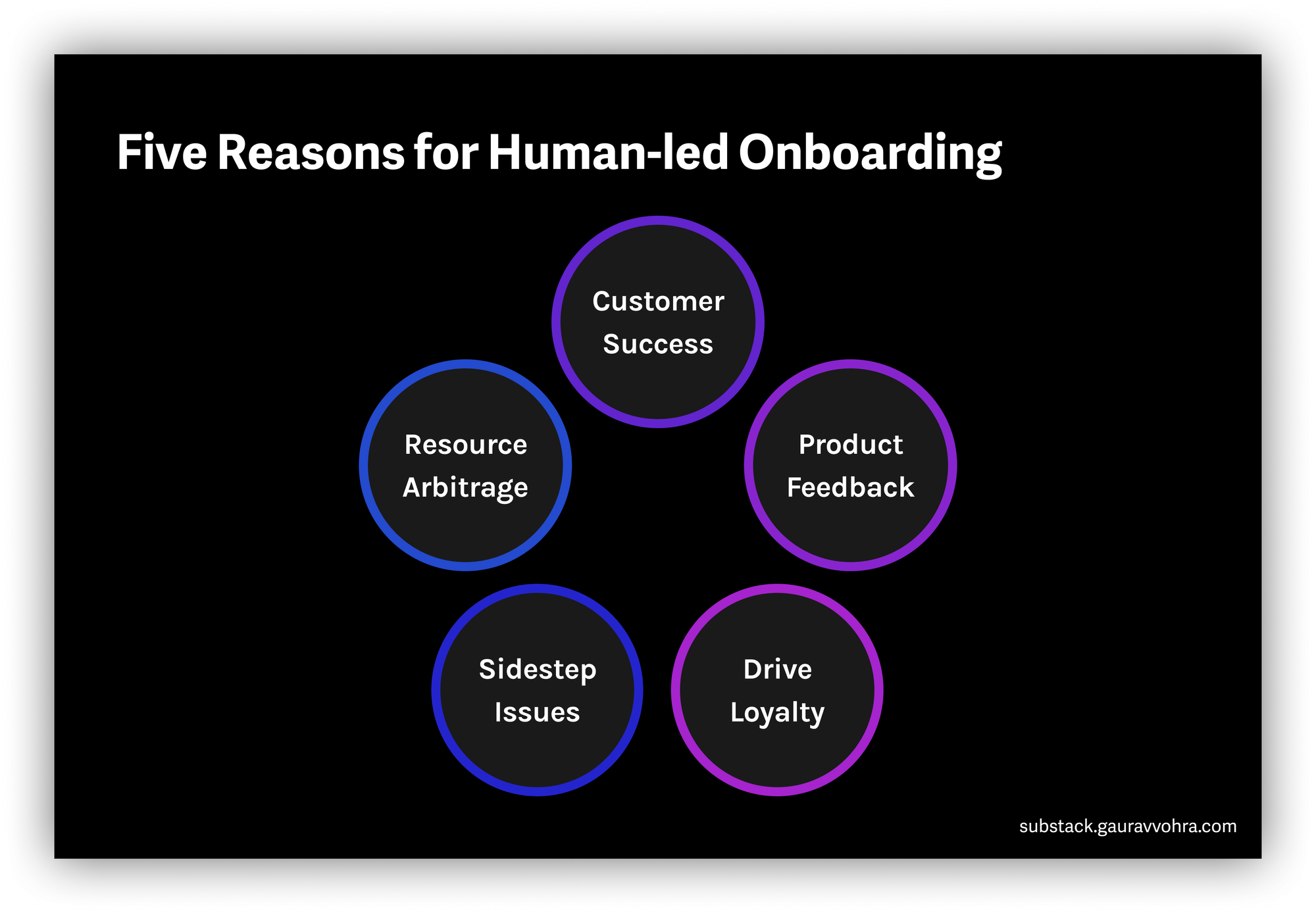
1) Customer success: world-class customer experiences
This is the most powerful reason of all.
Startups live and die by customer retention, and retention starts with activation.
Nothing activates a customer better than manually onboarding them to your product.
At Superhuman, we took inspiration from Apple's Genius Bar. You might walk into an Apple store expecting to buy a new MacBook Pro to watch Disney+ with your kids. But through a guided conversation, you'd walk out with a much better solution: a fully set up iPad, a kid-friendly case, and the knowledge of how to use it.
We also deeply considered premium experiences such as 5-star hotels. You might check in, exhausted, not knowing where to go next. But the concierge can pleasantly guide you to your room, or the spa, bar, or beyond.
As the founder or product leader, just like the Genius Bar staff or hotel concierge, you know the product best. You know every feature and every bug. You can anticipate every moment of delight and every sharp edge.
In other words, you can craft the perfect experience for each customer.
Let's examine a classical framework for activation, from Reforge's Retention Series:
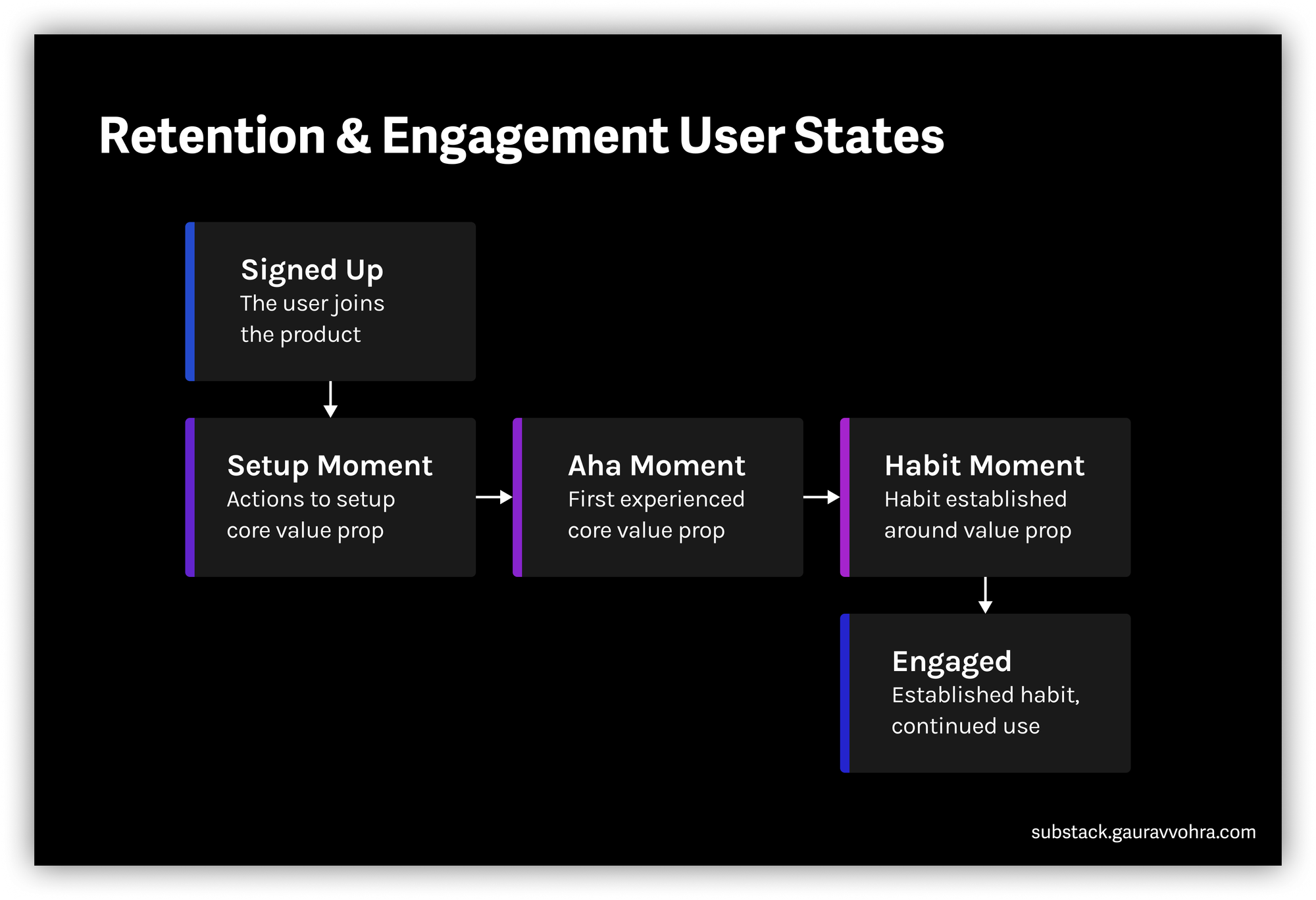
A human-led onboarding can push every new customer to make it through 'Signed up,' 'Setup Moment,' and 'Aha Moment.' If done well, it can set them up with 'Habit Moment,' and put them well on their way toward 'Engaged.' And it likely can be done in half an hour or less.
Over 65% of new customers fully transitioned their email to Superhuman after their human-led onboarding.
This was more than double what we observed by simply dropping users into the product, absent any in-app onboarding, and letting them figure it out themselves.
What indicators suggest customers may especially benefit from human-led onboarding?
Look for the following four attributes.

A) Changing a pre-existing workflow
Maybe the customer gets the job done today with different tools. Maybe they have existing data that needs migrating. Maybe they just have strong opinions.
If this is the case, they need to change their pre-existing workflow to adopt your product.
90%+ of early Superhuman customers had been using Gmail for over 10 years. They came with a tremendous amount of email baggage. It was common to see 100,000+ emails in the inbox, 10,000+ unread, and no good workflow for handling email.
Humans are exceptional at pattern-matching to swiftly identify issues and propose solutions. We could rapidly diagnose each customer's current setup in our human-led onboarding. Then, we could provide exact migration steps to persuade them to adopt a new and better workflow.
B) Learning a new physical paradigm
Perhaps your product demands that customers build new muscle memory. Or maybe it introduces new surface areas, never before seen.
Products with this property might have new interaction modes. Consider apps taking user input through novel swipe gestures, voice, movement, or image recognition. AI companies focusing on multimodality or robotics would fall into this bucket.
As an example, Superhuman was famous for popularizing keyboard shortcuts for everything.
Learning keyboard shortcuts is a very unusual experience. Like a piano lesson, our customers benefitted from a real human encouraging them to try new interactions, helping them turn awkward physical movement into fluid muscle memory.
C) A desire to see specific functionality
Your product might exist in a space with a wide variety of jobs to be done. This might be because the incumbents support a huge number of use cases, such as Superhuman tackling email or VimCal tackling calendar. Or maybe your product flexibly supports hundreds of potential workflows. Consider, for example, go-to-market tools like Clay or Iterable that have the potential to become company infrastructure.
If this is the case, customers likely have different features they want to see. And humans can jump straight to those features.
At Superhuman, an onboarding for a busy founder with an overflowing inbox might prioritize Auto Labels, Split Inbox, and Remind Me. Meanwhile, an onboarding for an outbound salesperson might deep dive into Write With AI, Snippets, and Send Later.
Personalization shortens time-to-value from days to minutes. Customers are delighted at how quickly they discover their new favorite feature and are more likely to become engaged.
D) A need to build repeated habits
Finally, your product might require that customers commit to recurring usage. Many products require repeated use to build growing value.
Examples of products that require customers to build a habit to unlock compounding value include gym memberships, e-learning, and productivity apps.
A live conversation is the most effective at persuading customers to make that commitment.
To bring this to life, the internal Superhuman onboarding playbook included the following list of tactics that Onboarding Specialists could use:
- Have customers verbally commit to the Onboarding Specialist that they will use Superhuman every day for the next 30 days
- Log into all email addresses in Superhuman
- Create a browser bookmark for Superhuman
- Pin the Superhuman Chrome extension
- Set Superhuman as the default desktop mail app
- Add Superhuman to their iPhone "home row"
- Set Superhuman as the default phone mail app
- Delete Gmail and Outlook bookmarks
- Delete Gmail and Outlook from the browser URL autocomplete
- Delete Gmail, Mail, and Outlook phone apps
With the most customer-centric reason for human-led onboarding now articulated, let's explore the company-centric reasons.
2) Product feedback: workflows, features, issues
The first company-centric reason is that each onboarding lets you rapidly and deeply learn about your customers, and how they interact with your product.
In Superhuman's early days, onboardings ran up to 90 minutes:
- The first 30 minutes were devoted to discovery: Learning about customers, their pain points, and their email and broader productivity workflows.
- In the subsequent 60 minutes, we would do the onboarding, during which time we would obsessively capture every feature request, bug, and point of friction, including ones the customer hadn't even noticed.
It was common to come out of each conversation with 10 pages of notes, 5-10 feature requests, and 5-10 bugs to fix before the next onboarding.
This depth of insight is impossible to gain from analytics alone, even with a session recording tool like Amplitude or FullStory.
Of course, as we scaled, we tightened all aspects of the operation. We pared onboardings down from 90 minutes to 30 minutes. Learning about customers shifted to a pre-onboarding Typeform survey, plus two minutes at the start of each call. And the number of feature requests and bugs encountered drastically went down as the product matured.
But the value remained: human conversation yields a continuous lens into who your customers are and what they care about.
3) Drive loyalty: methodically manufacturing evangelists
Spending live time with customers generates a tremendous amount of goodwill.
Customers see that you are real people putting in real work to make their lives better.
You can build personal rapport by going above and beyond to help them. During Superhuman onboardings, we would give productivity advice whether or not it had to do with email.
And you can establish connections to follow up on later.
We'd listen to what was going on in their work and lives, take notes, and make a point to ask about it later. For example, one customer had recently become a parent, and we'd follow up a few weeks later to see how they were doing. Another said they would be running a marathon, and we set a reminder to ask them their time. We'd connect with our customers on social media, bringing them closer to Superhuman, and invite them to events at our office.
This has the effect of making each customer, on average, far more loyal than if they spoke to no one at all.
Spending time with customers methodically manufactures evangelists.
This, in turn, results in the following positive outcomes over the customer's lifetime:
- Customers are more likely to stay engaged and retain.
- Customers are more likely to recommend you to friends and family.
- Customers are more forthcoming about their needs, feeding your product development cycle.
- Customers are more likely to report bugs they encounter, increasing your product quality.
4) Sidestep issues: from moments of disappointment to moments of delight
One of the best-kept secrets of the early Superhuman onboarding was how little the product initially supported. The earliest version was:
- Gmail only (no Outlook)
- macOS only (no Windows)
- Chrome only (no native app)
- Desktop only (no mobile app)
In addition, there were missing features that many customers simply expected — unified inbox, CRM integrations, and Grammarly support — to name just a few.
And yet, we were still able to delight a majority of customers.
How?
A major benefit of speaking to customers in person is being able to directly share why functionality is missing, while also noting their request so you can delightfully inform them later on.
Instead of the disappointing experience of discovering gaps on their own, customers are usually happy to hear that the startup knows a feature isn't ready yet but has it on its roadmap.
Then, they're intrigued when they see you write down their request. And they're blown away when you follow up to let them know their feature is available.
A similar flow can be used for any bug encountered: Observe it, troubleshoot in the moment, take note, and close the loop later on.
An in-person conversation can turn moments of disappointment into moments of delight.
5) Resource arbitrage: solving the hardest problems first
Last but not least, if you are resource-constrained, it's possible that you are better off dedicating build cycles toward core functionality.
Consider that an engineer could spend a week building a critical missing feature, or, they could spend that same week building the self-serve onboarding.
Humans can gracefully fill in for the lack of self-serve onboarding. But humans cannot fill in for critical missing features.
If push comes to shove, it's better to onboard the customer manually and build core functionality, than to automate an onboarding into an incomplete and potentially disappointing product.
Mandatory vs. optional
There is a critical choice to make between making human-led onboarding mandatory or optional for customers.
Companies with a sales-led go-to-market already face this dilemma: Should all new customers be required to 'talk to sales', even if the product could be self-served?
At Superhuman, we initially mandated that all new customers attend a 30-minute human onboarding to access the product.
Our unique combination of ideal customer profile (time-sensitive founders, who would later become sales decision-makers in a land-and-expand motion), competitive landscape (a fallback in Gmail), and price point ($30 per month), pointed to a "no customer left behind" mentality.
We would not leave it to chance that customers might hit critical issues in their first few moments. We wanted to provide everything possible to succeed with Superhuman.
We experimented with making the onboarding an optional step after accessing the product. Even with our most pushy lifecycle marketing, the typical attendance rate was 15% — down from 100%.
Cost-benefit analysis
We have explored reasons to conduct human-led onboarding. But in many founders' minds, human-led onboarding sounds so expensive that they might never consider it.
A practical approach is to fully reason through a quantitative cost-benefit analysis. Let's unpack the trade-offs using Superhuman's numbers as a starting point. Take this structure and apply it to your own product.
Benefits
1) Revenue
Each fully ramped, full-time Onboarding Specialist was able to add up to $650k of topline ARR per year.
Assuming enough customer demand, each full-time Onboarding Specialist could lead 8 to 12 half-hour calls per day, or 4 to 6 hours per day. This provides room for asynchronous activity such as supporting new customers over email, as well as team rituals, and breaks.
The biggest inefficiency was unexpected customer no-shows. At Superhuman, this averaged 15% and spiked as high as 30% during public holiday weeks such as Thanksgiving.
Net of no-shows, each teammate aimed for 40 completed calls per week, over 45 weeks per year. The remaining weeks were expected to be vacation, public holidays, company offsites, and other out-of-office.
At Superhuman's price point of $30/month, this set of assumptions amounted to 40 customers * 45 weeks * $30/mo * 12 months = approximately $650k per Onboarding Specialist per year.
2) Improved activation and retention
As mentioned above, human-led onboarding saw nearly 2x the activation rates versus self-serve.
It is worth noting that this was hard to perfectly test. Due to selection bias, the segment of customers willing to show up to a 30-minute call was always a subset of the segment willing to self-serve into a product. So we paid extremely close attention to qualitative signals: Customer feedback both during and after the call.
Even if the actual uplift was half of these numbers, a 1.5x lift would still blow any normal self-serve onboarding experiment out of the water.
3) Virality
We saw the same 2x uplift in customer virality: Double the number of referrals per customer who was manually onboarded.
Again, to be cognizant of selection bias, we paid special attention to social signals.
Early "whale" referrers publicly shared their referral ability on social media, sometimes garnering over 300 referrals per customer.
And we continuously see founders bring Superhuman to their teams many years into the future.
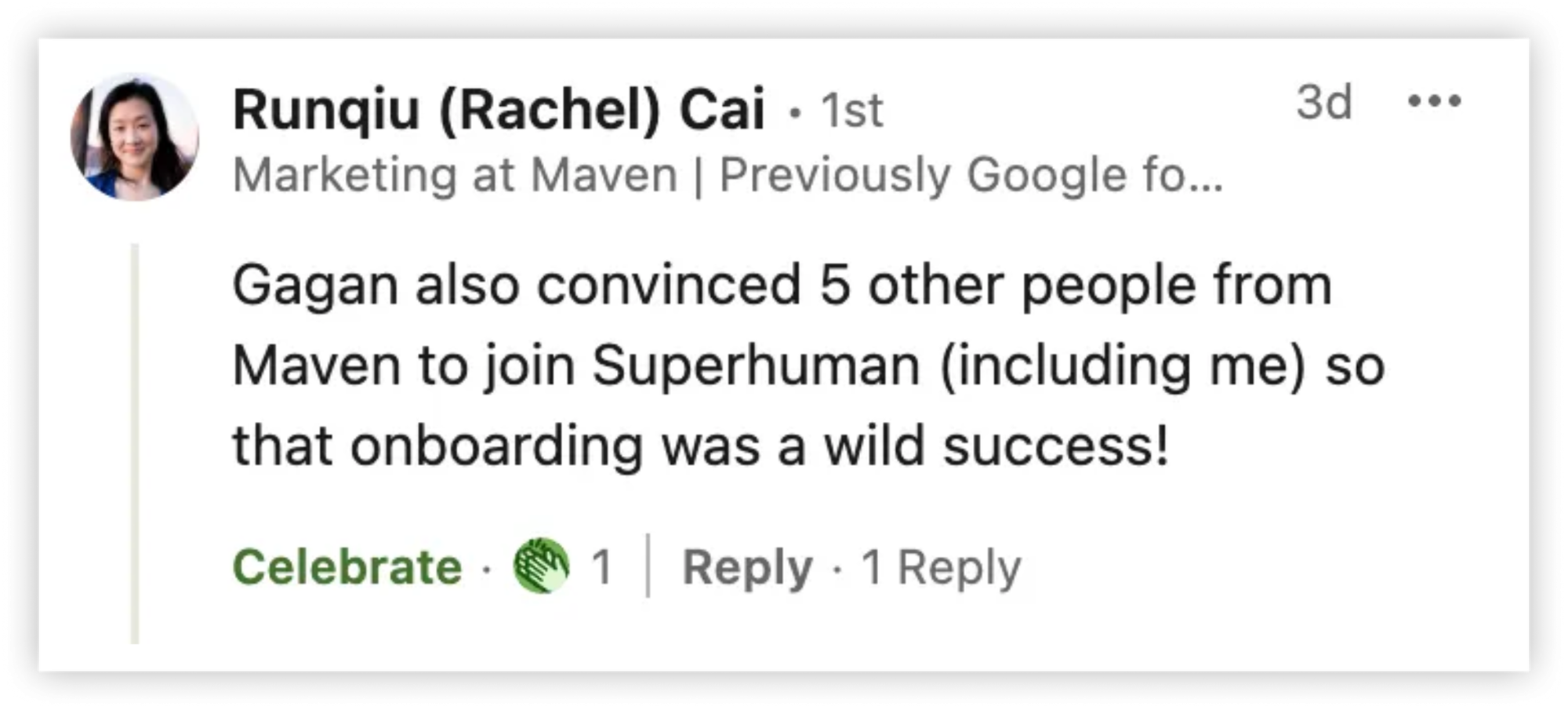
4) Accelerated learning
We were able to learn about customer needs several orders of magnitude faster. Feedback loops that might have taken weeks could be observed within minutes and closed the same day.
5) Brand boost
Superhuman undoubtedly benefited from the brand benefits of manufacturing legions of evangelical early adopters. The downstream benefits are far-reaching and many.
Costs
1) Operating expense
A full-time Onboarding Specialist based in the Americas might cost anywhere from $60k to $130k fully loaded.
2) Manager expense
At scale, each squad of 10 Onboarding Specialists required one full-time manager, and approximately 10% of a full-time executive (at the time, me).
A sensible concept for evaluating these costs is sales efficiency: A team generating at least 3x the revenue as what it costs is generally considered good.
Of course, manager time carries a further cost that must be considered: The opportunity cost of that time not spent elsewhere.
3) Supply and demand mismatch
Human-led onboardings introduce a challenge that is very typical for fixed asset businesses, such as airlines or doctor's offices, but somewhat alien to most startups: A supply and demand mismatch.
The problem is that at any point in time, customer demand and onboarding supply never perfectly equilibrate.
Most founders rightly worry about customer demand exceeding onboarding supply, ultimately throttling growth.
But the concern also runs the other way: Too much supply creates operational inefficiency.
These challenges were most apparent for customers in different timezones and over weekends. They were also apparent for large demand spikes such as right after a launch, and large demand troughs such as over Thanksgiving and Christmas.
4) Customer experience
Some customers experienced frustration waiting for and attending their onboarding.
For a suitably short wait and suitably incredible onboarding, this was a non-issue. But, there will always be customers who are better off figuring out how to use the product themselves, especially in certain industries. For example, it's commonly the case that engineers prefer to try products themselves, which is why most developer tools avoid 'talk to sales', and have a self-serve option.
Of course, each startup will vary drastically in these benefits and costs. At any moment in time, it's important to understand yours, and identify your single decisive reason for picking one path over another.
With costs and benefits fully explored, let's zoom out to a broader framework of how long to practice human-led onboarding.
How long to practice human-led onboarding
As above, I believe every startup should start out doing human-led onboarding.
In the beginning, the benefits of generating revenue, delighting customers, accelerating learning, and building a brand most likely outweigh the costs. But there is a question of when, if ever, to transition to self-serve.
This can be boiled down to a 2x2. On one axis is the price point, which can be thought of as Average Revenue Per User (ARPU) or Average Revenue Per Account (ARPA). On the other axis is product complexity, which is a proxy for the benefits previously explored.
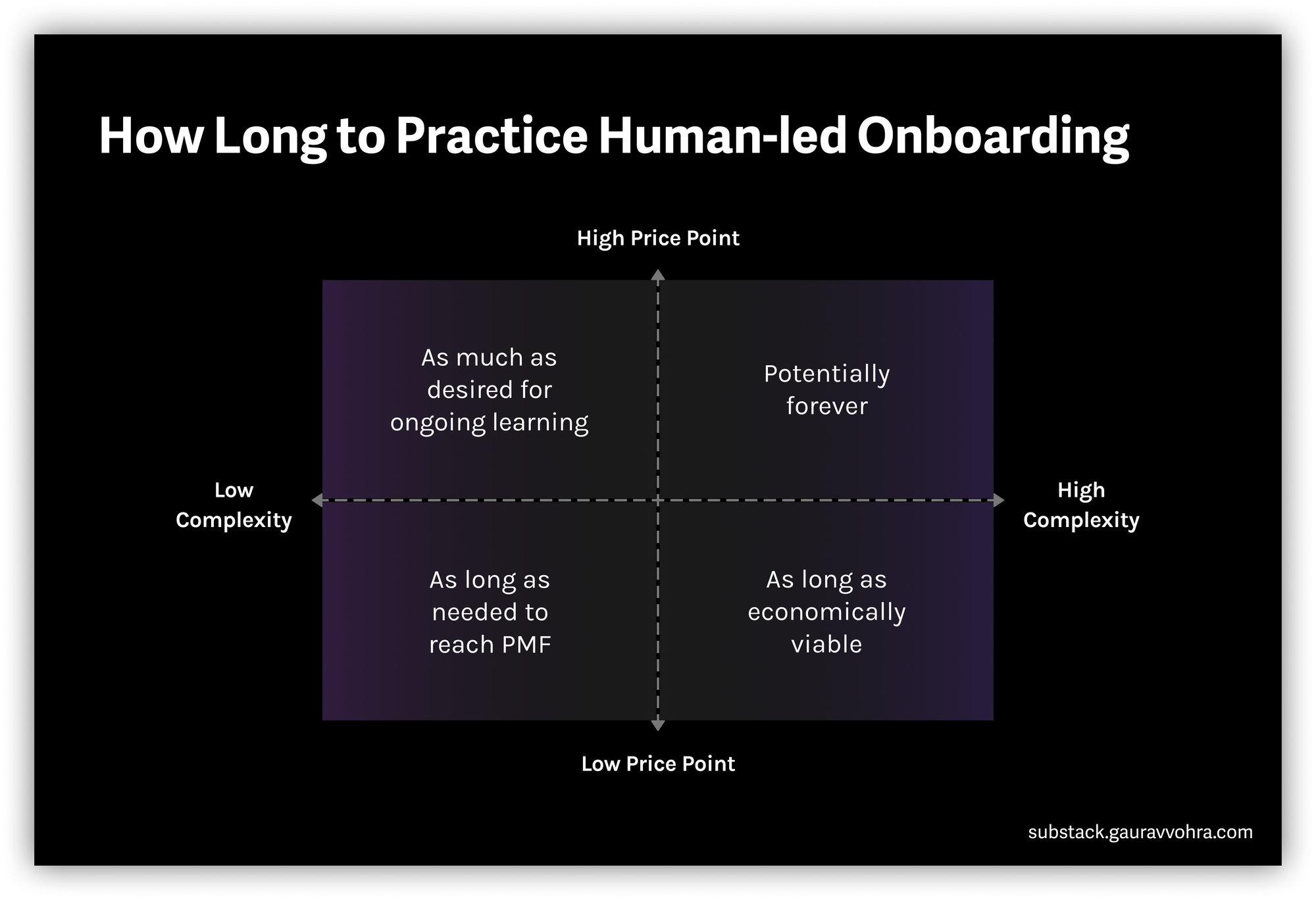
High price point, high complexity: potentially forever
Imagine complex B2B SaaS at a high price point. Examples might include a CRM or marketing automation suite. Or imagine a high-end direct-to-consumer service, like personalized healthcare.
These products might benefit from human-led onboarding for a very long time — potentially forever, via an Implementation or Solution Engineering team.
Implementation can be baked into your expected cost to acquire a customer (CAC), in turn supporting a high expected lifetime value (LTV).
High price point, low complexity: as much as desired for ongoing learning
Imagine an expensive product that is also extremely easy to understand. Examples might include car insurance or a talent marketplace.
These products generally don't need human-led onboarding after the startup has reached product-market fit.
These startups can decide how much they want to continue onboarding manually. The most durable reason is typically to support ongoing learning.
Low price point, high complexity: as long as economically viable
Consider a startup intentionally keeping prices low to win market share, even if the product is complex. Imagine a new CRM aggressively discounting, for example.
These startups should manually onboard customers for as long as economically viable. Their objective is to make customers successful while winning the market.
Over time, they can increase prices to justify continued human-led onboarding. Or they might do the challenging work of building a self-serve onboarding.
Low price point, low complexity: as long as needed to reach PMF
Finally, imagine a tool with an extremely simple value proposition, that is either very cheap or free to get started with.
Most consumer software falls into this quadrant. Consider gaming, social media, or utilities like photo editing.
These startups should manually onboard early customers only as long as necessary to reach PMF. Beyond that, the costs of onboarding likely will not be further justified beyond ad hoc product learning.
Superhuman: existing in superposition
In general, startups exist in a superposition across this 2x2. Different tiers or customer types might reasonably require different onboarding motions. The free tier might be entirely self-serve, while the enterprise tier might be entirely human-led.
To design your onboarding flow, consider each SKU and persona as though they were their own distinct product.
Superhuman began in the top-right quadrant: High price point, high complexity. For example, a CEO with fifteen years of email baggage to migrate, whose thousand-person company represented a future six-figure revenue opportunity. These were customers we wanted to spend one-on-one time with: The beginning of a sales motion. And we still seek to manually onboard these customers.
But at other times, we existed in the lower-left quadrant: Low price point, low complexity. For example, students on a discount tier, who are already hyper-efficient and able to hit Inbox Zero. We implemented a carve-out to let all students self-serve as soon as we found product-market fit.
As we scaled beyond the highest-expectation customers of Founders and CEOs towards go-to-market professionals and wider teams, we increasingly found ourselves in the lower-right quadrant: Smaller long-term revenue opportunities, but sufficient complexity to require human-led onboarding.
We scaled human-led onboarding until the costs, particularly supply and demand mismatch, overtook the benefits. This precipitated a steady transition towards a productized onboarding.
Part 2: Unconventional wisdom for productizing onboarding
Nearly all products — except for the most expensive and complex — eventually transition to some kind of self-serve onboarding.
But the transition can be tricky to get right.
Plenty has been written on the topic of what a good product onboarding entails. Some of my favorite materials include The Elements Of User Onboarding, What is a Good Activation Rate, and the Activation sections of Reforge's Retention Series.
I recommend readers absorb these guides to build a good mental model for how to productize onboarding.
But despite these materials and more, I noticed an under-served area in onboarding literature: What specific qualities should product onboardings contain? How should they feel?
Product and growth teams — particularly those who have spent limited time 1-1 with customers — often struggle with these questions. This results in watered-down, unmemorable experiences.
But coming from human-led onboardings, the answers felt obvious.
What you'd tell customers in person
When building your product onboarding, imagine you were right there with customers, just like a human-led onboarding.
- You would comprehensively guide customers to accomplish their setup moment.
- You might have a predefined workflow or reverse demo to get them to their aha moment.
- You would carefully watch for issues, and jump in if you notice any hiccups.
In other words, you'd be extremely attentive to the customer's every need.
Reforge likens this to removing one's marketing hat and thinking like a personal assistant.
This helps with function, but it doesn't fully explain form. How might software further replicate what a human might do?
We needed a second source of inspiration. So we asked: Where else are there countless examples of software guiding users through a brand new world?
We turned to a long-standing source of inspiration at Superhuman: video games.
For decades, video game creators have been perfecting the art of dropping players into new and complex worlds and then setting them up for success. They teach players to learn the controls, take action, and embark on their adventure.
I discovered that the most effective product onboardings embody three attributes that product and growth teams typically shy away from: opinionated, interruptive, and interactive.
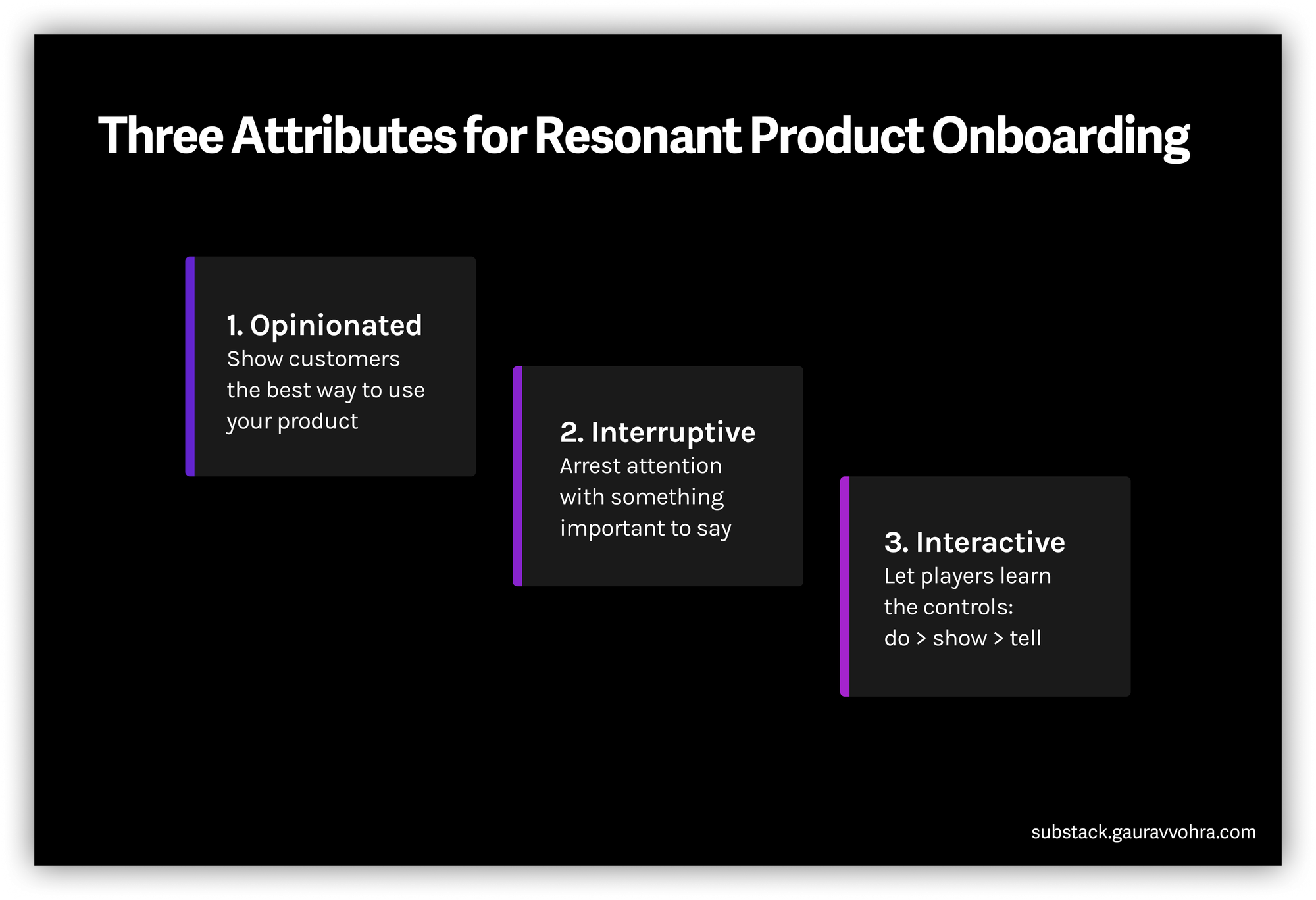
1) Opinionated
What it means
There are many ways to use your product, but there is likely a best way. And you owe it to your customers to help them down that path.
This is the path that most rapidly accomplishes the setup moment, reveals the aha moment, and primes the habit loop.
Nan Yu, Head of Product at Linear, describes the following: When you adopt business software you're often adopting a practice along with the tool. You're adopting packaged wisdom and putting it into practice.
This perspective applies just as readily to consumer software as it does to business software. For example, Duolingo has a point of view on how you should learn a new language. Airbnb has deeply held beliefs about what it means to travel and host.
At the core of every great product is a problem that exists in the world, and its creator's opinionated solutions to that problem.
New users come to your product looking for those solutions.
Inspiration
We drew inspiration from one of the most iconic video game experiences in history: 1985's Super Mario Bros 1-1.

This level is a masterpiece in opinionated design. Without instruction, the player is encouraged to move right. Then, as the Goomba trundles towards you, you must either jump or perish and restart the level.
It opinionatedly tells the player: "This is a game about jumping. You will learn to jump perfectly."
As you proceed, you learn everything needed to succeed — movement, enemies, power-ups — all in pursuit of your goal.
How to do it
Consider the following simple exercise: What would you tell the customer if you only had 10 seconds? What about 1 minute? How about 10 minutes?
Progressively follow this thinking and capture the most salient messages.
Some of my go-to opinionated onboarding elements include:
- A mandatory introduction video that gives the product elevator pitch and tees up the user's next steps.
- An on-rails experience where users must take certain actions to build familiarity.
- Dropping users into a stripped-down version of the product containing only the flows relevant to brand-new users.
Case Study
Superhuman's first self-serve onboarding was hyper-opinionated. Similar to Super Mario Bros 1-1, we opted for an experience that taught users to move in a controlled environment.
The first step drew inspiration from requiring Mario to move right: We required users to hit "enter" to get started. Clicking buttons made them jiggle helplessly, encouraging users to abandon the mouse.
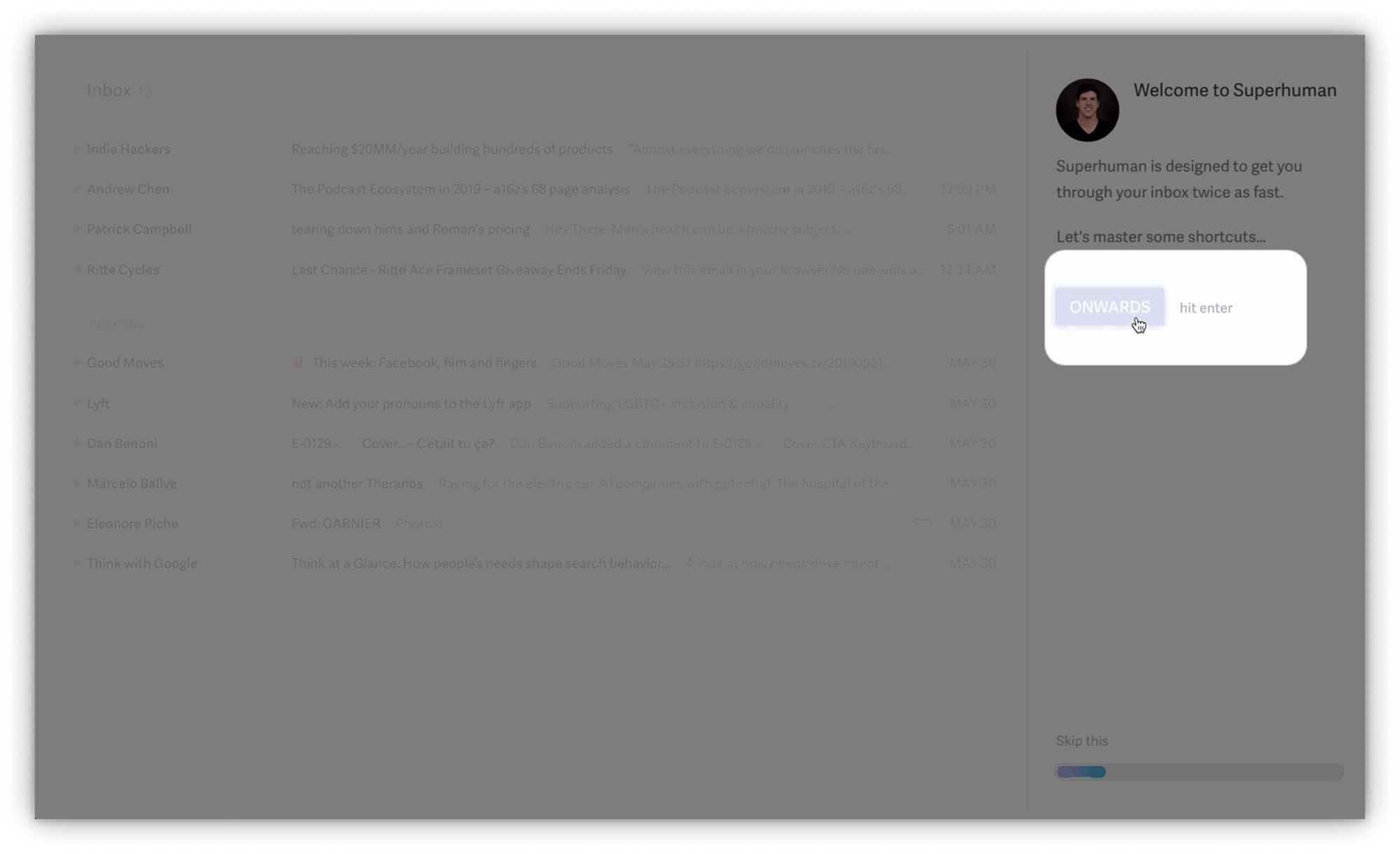
The demo then stepped through basic navigation, such as "j" and "k" to scroll through emails.
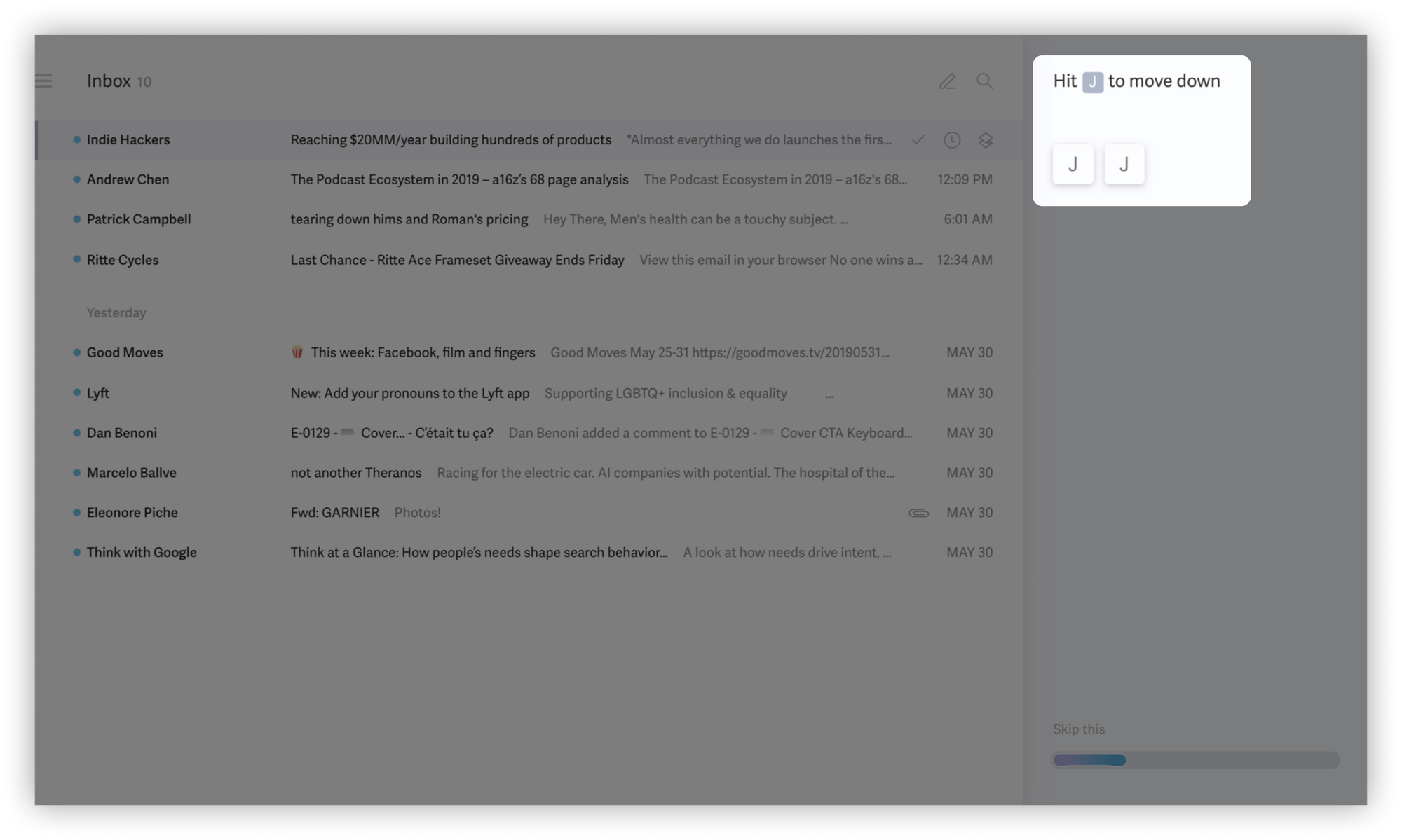
This first version worked. But we knew it could be much better.
Samuel Hulick of useronboard.com even told us at one point: Teaching navigation this way felt like we were forcing users to "eat their vegetables."
In our next iteration, we strongly prioritized our most opinionated objective: Inbox Zero. We removed navigation like "j" and "k", and prioritized the controls necessary to hit Inbox Zero: Marking done with "e" and setting reminders with "h."
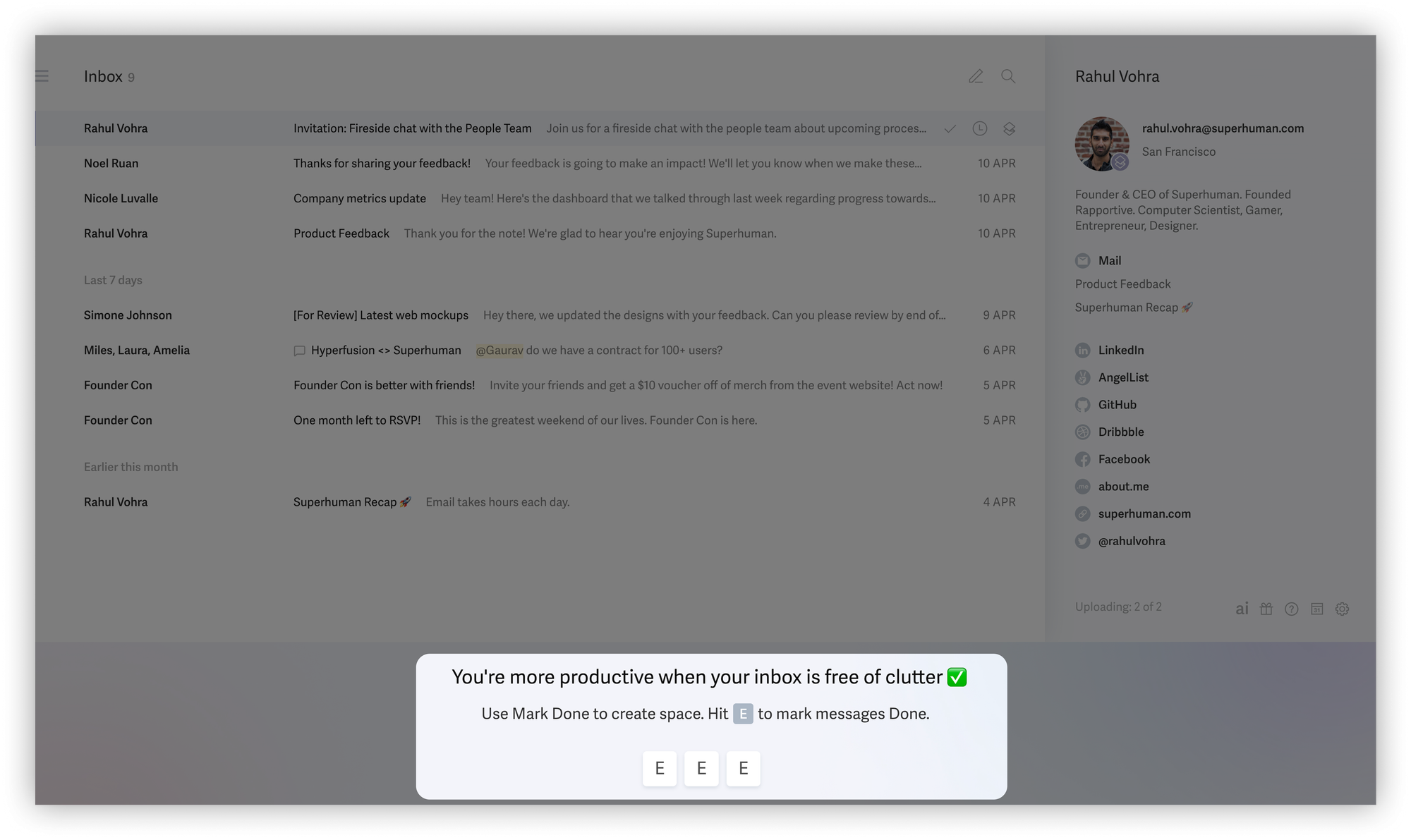
This shift had astounding results: "e" and "h" usage increased by 50%, and self-serve activation rates improved by 25%, from 40% to 50%.
2) Interruptive
What it means
Great onboardings dare to be interruptive.
In the last 15 years, unobtrusive elements like checklists, tooltips, and in-line nudges have somehow become an industry standard.
Particularly on desktop, it is typical to click through a series of tiny tooltips when onboarding to a new product.
Over time these elements become clutter, piling up in the corners of your app. Cruft that slowly degrades the new user experience, dividing user attention between guidance, and the product itself.
If an experience is tucked away, it will be ignored. And if it is ignored, it may as well not exist.
Great product onboardings arrest a user's attention with something important to say.
Inspiration
Our source of inspiration was the unforgettable "Hey, listen!" call from Navi, Link's fairy helper in 1998's The Legend of Zelda: Ocarina of Time. Navi shouts when there is salient information necessary to make progress.

It might be a meme, but this guidance goes beyond simple help, forming an emotional bond that many players remember decades later.
How to do it
Again, consider what you might say in person. If your customer had missed a crucial concept, you'd earnestly jump in. The product should be no different.
At the outset, it's important to establish a golden rule: If you are going to disturb the user, it needs to be for something extremely valuable.
This filters out 90% of what you might interrupt the user with. It leaves you with only the ideas that you absolutely must convey.
These interruptions might be at the very beginning. Think about, for example, when you set up a new iPhone. The entire screen is dedicated to core setup: Face ID, Location Services, iCloud login, and more.
Or they might be deeper into the journey. Consider Headspace greeting you with an explanatory video from the founder after your third meditation, or Simply Piano enticing you after your first lesson with a preview of becoming a proficient musician.
It is critical to identify concepts that are useful to a high enough percentage of users. And these moments must be timed extremely thoughtfully — optimizing for moments of high user receptiveness, and avoiding moments when they might lose context or progress.
Case study
At Superhuman we experimented with checklists, tooltips, and timed nudges. These yielded zero impact.
The checklist was the most surprising. We hypothesized that users would be completionists, seeking to accomplish every step in a checklist.
So we gave them "side quests" to complete: Clean up old email, activate Superhuman AI, and more.

Only 50% of users completed each task, and only 30% of users completed all tasks. And we saw no change in activation rates. Worse, we now had an experience obscuring a core piece of functionality.
Reflecting on our sources of inspiration — Navi's interruptive call, the iPhone onboarding mentioned above, and more — we rebuilt the checklist as a full-screen experience.
We shifted from steps in a tucked-away checklist to full-screen panels before hitting the main product. And we made them impossible to skip, instead providing smart defaults so users could quickly zip through.
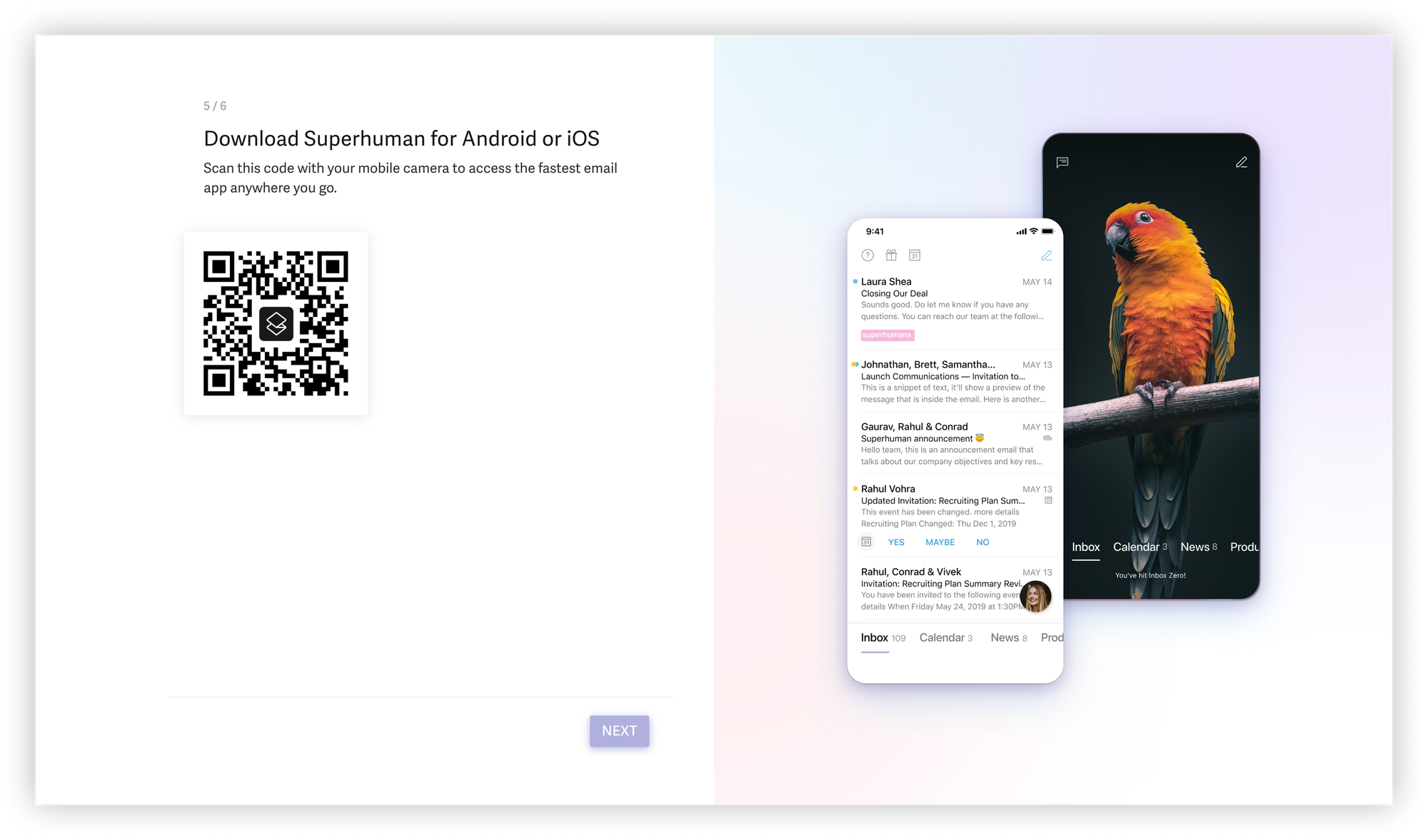
This drastically elevated total completion rates from 30% to over 98% — because users were required to complete the steps or bounce entirely. And opt-in rates for key features rocketed from 45% to nearly 80%.
We then took this insight to several other areas of the user experience. Perhaps the most extreme is "Get Me To Zero." This step interrupts customers right before they hit their "real" inbox, persuading them to pick a date, such as three days ago, and Mark Done everything before then.

For anybody who takes their email seriously, this might feel incredibly scary.
Despite this, an astonishing 57% of new users opt in to "Get Me To Zero," and it is responsible for archiving close to a billion emails and counting.
3) Interactive
What it is
A common objection to being opinionated and interruptive is that it removes agency from users.
The antidote is to make these experiences interactive.
The pedagogy mantra of "do > show > tell" can be applied: Customers retain far more when they have directly taken action.
Moments of interaction have the added benefit of building up user muscle memory.
And last but not least, they are fun!
Inspiration
Video games, by definition, put players in control. Our specific source of inspiration was an experience from Super Smash Bros: A Training Mode that lets new players try every button in a safe environment.

The magic of this experience is giving players 100% agency at the same time as 100% safety.
How to do it
When pushing a message during the onboarding, ask yourself: What action could a user take to internalize this message?
This might be a setting to toggle, CTA to click, or feature to play with. These actions help customers internalize and remember your message.
Then ask: How can you make it as safe as possible to take this action? One of my favorite mental models for new user onboarding is "the user is drunk." So it's important to prioritize simplicity and safety. You must make clear what the action is, when it is needed, and how it can be done. And you must make sure the user is protected against adverse outcomes, like losing work.
Finally, it's best practice to have customers use your product to learn the product. A brilliant example of this is Readwise's read-it-later app, Reader. Reader pre-loads an article from the founder explaining how to use the product. Throughout, it self-referentially explains how the user should interact with that article, including highlighting, notetaking, and ultimately archiving.
Case study
The centerpiece of Superhuman's onboarding is a synthetic inbox within which users can clear emails and hit Inbox Zero. It is fully interactive and entirely safe.
This was such a success that we wanted to replicate interactivity elsewhere in the onboarding.
In Superhuman we teach new users how to "Undo Send." The best time to learn this isn't during setup, or even just before sending. It is in the split second after sending, when context around sending is at an all-time high, and when users may safely try the feature.
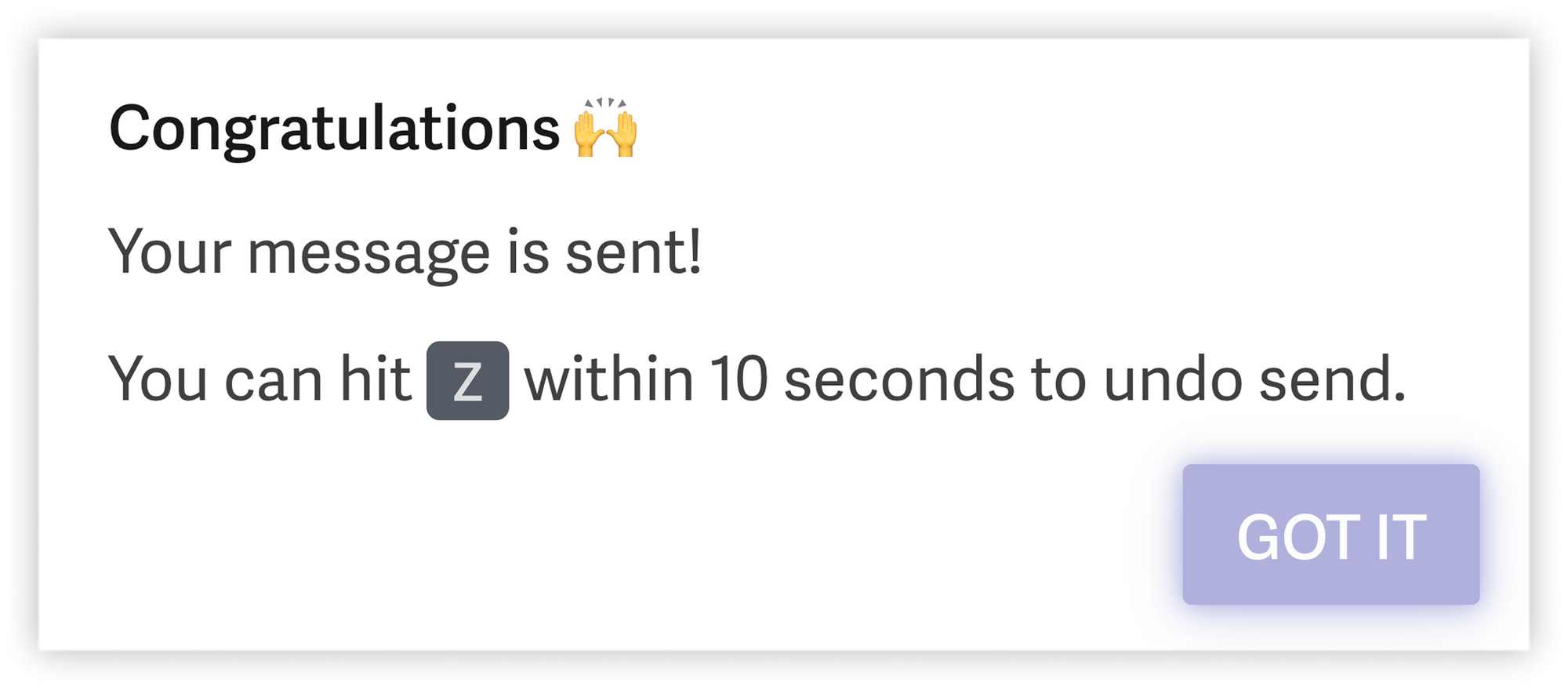
When we notify users about "Undo Send," we don't just explain the feature. We make it so that tapping "Z" actually undoes the send. Meanwhile clicking "Got it" safely dismisses the alert, while allowing the user to "Undo" for another 10 seconds.
This arrests attention with the initial interruption, and then safely allows the user to play with the feature, unlocking a sense of satisfaction.
Why is this hard?
One of the most fascinating aspects of product onboarding is unpacking why teams shy away from building opinionated, interruptive, and interactive experiences.
Founders, product, and growth leaders should be vigilant against these traits, and work to erase them from company culture.
Lack of conviction
A common challenge is the startup lacking conviction in its ICP, and their jobs to be done (JTBD).
It is understandably difficult for the onboarding to be opinionated if the product itself is not.
This is especially common when a startup is bringing a technology or capability to market, prior to being specific about who, exactly, they are building for.
It is also common when a startup has multiple customer profiles with a wide variety of jobs to be done. This creates decision paralysis where the startup does not know how to balance the various personas.
In both cases, it is critical to pick the most important ICP and their most important JTBD, and then build the best possible flow for that. These decisions are rarely one-way doors.
Better to pick a path with conviction and pivot if required, than to never pick one at all.
In the case of products serving multiple personas, once a primary ICP has been chosen, it is much less work to branch the experience for different personas. This is typically done by customizing suggested content and workflow for new users.
For example, social apps like Pinterest and X and media apps like Netflix and Spotify commonly ask new users to pick their interests to seed their recommendations. Meanwhile, SaaS apps like Miro, Airtable, and Notion all have some version of asking users for their use-case such as education, work, or personal, then suggesting templates matching those details.
Fear of backlash
It is extremely common for teams working on onboarding to fear backlash, either from customers or from within. Shaping the onboarding for 100% of future customers is already a big deal. Being opinionated, interruptive, and interactive only heightens that tension.
Consider controversial moves such as making an explainer video mandatory, changing a setting to be on-by-default, or removing 'skip' options from the onboarding.
The antidote is rapid testing to reduce risk. Tests, by definition, are reversible, with a clear framework in place of when to proceed versus when to backtrack. It is natural for stakeholders to balk at a controversial onboarding step — until it yields a 10% improvement in activation.
Faulty ecosystem
Typical plug-and-play elements for onboarding such as checklists and tooltips approach onboarding the wrong way. They are simply widgets that are the easiest to drop in.
They do not represent what customers need most, and they certainly do not match the nuances of your product.
Instead of being swayed by the typical menu of options, think deeply about what customers need to understand your product. You might be able to create these solutions through low-code solutions, but consider that your solution might require a more bespoke approach.
Create delight
At the root of everything I've described is an obsession with the customer.
Customer obsession is one of those squishy values: Oft-touted, rarely operationalized. We built Superhuman around the concept so deeply that our core value, Create Delight, permeates every part of the company.
There is no better way to build the best experience in the world for your customers than speaking to hundreds, if not thousands of them. Our Onboarding Specialists did just that, onboarding thousands of customers. Special appreciation must go to Kyle-Prescott Ogunbase with the most individual customers to his name at over 3,900. Others including Laurel Johnescu and Matt Waters, conducted thousands of calls, then became managers, leading the growing team that delivered countless more delightful experiences. And our Growth Product Manager Ben Ophoven-Baldwin and Pod obsessively drove product improvements from the insights they gleaned. Their customer dedication astounds me to this day.
We made a simple but important decision to place the customer at the center of everything we did at Superhuman — and from there, it shaped everything we do.
